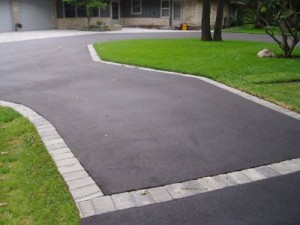 Our driveway had settled next to the garage entrance by approximately three inches and it was time to find a solution. Our choices were to replace the asphalt with a new asphalt driveway, to replace it with patio stones in its entirety, or to keep the asphalt and apply patio stones with some sort of design that would minimize our cost and also enhance our homes view from the street. We chose the paving asphalt driveway design with a patio stone design that involved a half moon approach at the top of the driveway and borders down each side of the driveway. We considered other designs, but settled on this one as the most attractive in our opinion.
Our driveway had settled next to the garage entrance by approximately three inches and it was time to find a solution. Our choices were to replace the asphalt with a new asphalt driveway, to replace it with patio stones in its entirety, or to keep the asphalt and apply patio stones with some sort of design that would minimize our cost and also enhance our homes view from the street. We chose the paving asphalt driveway design with a patio stone design that involved a half moon approach at the top of the driveway and borders down each side of the driveway. We considered other designs, but settled on this one as the most attractive in our opinion.
It was also the most cost-effective as well since a new driveway was going to cost over $5000, while this do it yourself project cost less than $500 not including the bricks which we already had leftover from a previous project. While it was very hard work and not something I would recommend for the casual do it yourself consumer, it is very rewarding to have completed it and saved a great deal of money at the same time.
Paving Asphalt Driveway Design – Construction
Once we had finalized the driveway design it was time to begin construction. The most difficult part was laying out the circle. basically we had to find a center point in the driveway and then scribe a circle that left a border equal distance from both sides. We also wanted to come out 5 feet from the edge of the garage to provide adequate slope for water dispersal from the home. This also represented the point where the settling of the driveway had stopped. We then cut the asphalt using a skill saw and an appropriate blade to cut the asphalt. Once the asphalt was removed, the gravel was set to the proper level and compacted. The patio stones could then be placed as per the design.
Paving Asphalt Driveway Design – Finishing Touches
Once all of the patio stones are in place, a sand concrete mixture is placed on the patio stones. This mixture fills the joints between the stones. Then the compactor is run over the stones to settle them all in place. This process also evens out the level of the stones so that they are all the same. In addition, the vibration from the compactor causes the sand to settle to the bottom of the joints. More sand is added. The compaction process is repeated until the sand completely fills the joints between all of the stones.
This sand mixture then must be dampened. This triggers the cement mixture in the sand to harden in place and become impervious to water and plants. The trick is to only spray the bricks with a very light mist. Too Much Water and the sand will not harden properly. We also resealed the existing asphalt to protect it. This application will return it to the like-new condition when it was when first installed.